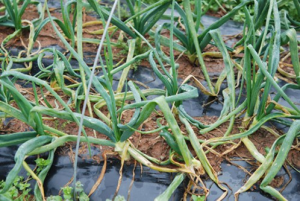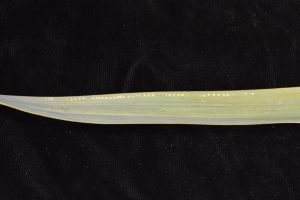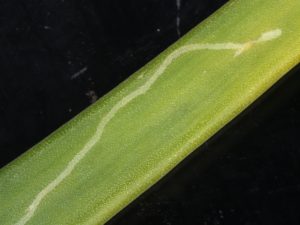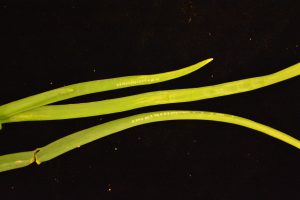As of Friday, April 21, we confirmed that ALM is in south Jersey and it is likely that it can be found throughout the state. Infested field chives were found in East Vineland as well as in backyard chives in Atlantic County and onion sets in the Middlesex/Monmouth County area. Feeding scars have been found in wild garlic which is abundant in New Jersey. So far, adult flies have only been trapped in chives. Given how chives are harvested, it is difficult to assess how damaging the fly will be to the chive crop. More of a problem will be protecting longer term crops like leeks and onions. [Read more…]
Search Results for: allium leaf
Allium Leafminer Alert II in New Jersey
A survey of fields from Princeton/Pennington in Mercer County northward through Milford and Asbury (Hunterdon County) and east to Chester in central Morris Co. revealed heavy allium leafminer feeding and active adults in chives only. There was only one garlic plant at the Pennington site that had feeding signs. Yellow sticky cards from chive plots in the Princeton area had numerous adults, but cards from a garlic field in Pennington did not have leafminers despite being within 200 yards of an infested chive plot.
At this point, allium leafminer adults appear to be favoring chives for feeding and egg laying. As one of the earliest and most succulent allium leaf types, chives may be a good indicator of the onset of adult activity, and could be useful as we decide when to begin protecting our other allium crops, including overwintered leeks, garlic and onion plants now being transplanted. Because egg laying is now happening, the prudent course of action would be to protect these crops, either with row covers or with recommended insecticides. These include Trigard, Scorpion, Radiant and Entrust (OMRI-approved). For a complete list see the RCE Vegetable Crops Online Resource Center Critical Updates to the Mid-Atlantic Commercial Vegetable Recommendations.
If you wish to inspect crops in your area, start with chives. Observe the tallest leaves first, and look for lines of characteristic white spots. These are wounds made by the female as she pierces the leaves to lay eggs and extract plant sap on which to feed (see photo below).
As a review, allium leafminer has spread from Pennsylvania into New Jersey, New York, and Maryland. At present, the main area of infestation in New Jersey appears to be in the northern counties. Only one suspected fly has been caught (Fall, 2016) in southern New Jersey in East Vineland. Traps set in this southern area will be checked this week. The Vegetable IPM Program will continue to track the spread and population levels of ALM in New Jersey.
Allium Leafminer Alert in New Jersey
Numerous adult flies of the allium leafminer (ALM) have been found in field chives at an organic farm in Mercer County. The chives were near a high tunnel that had plant material where the flies had overwintered as pupae. Because of being in the high tunnel the flies emerged sooner than unprotected field populations. The adults apparently have been controlled by the farmer with an application of Pyganic.
Allium leafminer has spread from Pennsylvania into New Jersey, New York, and Maryland. At present, the main area of infestation in New Jersey is in the northern counties. Only one suspected fly has been caught (Fall, 2016) in southern New Jersey in East Vineland. We have set traps at several farms, mostly in the north, which will be checked this week. The Vegetable IPM Program will continue to track the spread and population levels of ALM in New Jersey.
Pest Alert: Probable Allium Leafminer infestations found in NJ
Two probable infestations of allium leafminer have been discovered. One of these was on the Hunterdon/Warren County border involving overwintered garlic and onions planted this spring. The second, a very minor infestation, was found near Princeton in Mercer County on overwintered chives. While we await word from USDA as to where specimens should be sent for final confirmation, the signs of infestation are very characteristic of allium leafminer, and larvae and eggs were found in association with the egg laying scars (oviposition scars) on the leaves of onions and garlic. Both of these infestations appear to be very recent, with larvae in very early growth stages. [Read more…]
Allium Leafminer, a New Invasive Pest
Allium leafminer, a leafmining fly, was found about two weeks ago in Lancaster County, Pennsylvania. Since then the leafminer, which feeds on onions and related plants, has been found in four more counties in eastern Pennsylvania; Dauphin, Delaware, Chester, and Lehigh. This is the first time that this fly has been found in the western hemisphere. It belongs to the family Agromyzidae, which has many leafmining species.

Weakened leaves caused by larvae of allium leafminer. Photo by L. Donovall
[Read more…]
IPM Update 5/08/24
Sweet Corn
IPM personnel have deployed black light and corn earworm (CEW) pheromone trap networks in central and northern New Jersey counties. In areas from central Burlington County southward, grower cooperators have been provided with CEW pheromone traps and will be monitoring these traps on their own properties and reporting catch data to IPM personnel. This is an effort to maintain a statewide reporting program for the most significant economic pest of sweet corn despite a shortage of professional staff this year. The IPM program thanks these growers in the southern counties for their assistance in maintaining this necessary service.
Black light trap derived maps for European corn borer (ECB), CEW and brown marmorated stink bug (BMSB) will not appear in the Plant and Pest Advisory, as there is no statewide blacklight trap network. Data from existing black lights in the central and northern counties will appear in table format, with associated information on the relevance of the populations. Provided that data from the southern CEW pheromone traps is available on a regular basis, maps will be generated for this pest/trap type. Limited collections from traps thus far have not contained any target pests.



